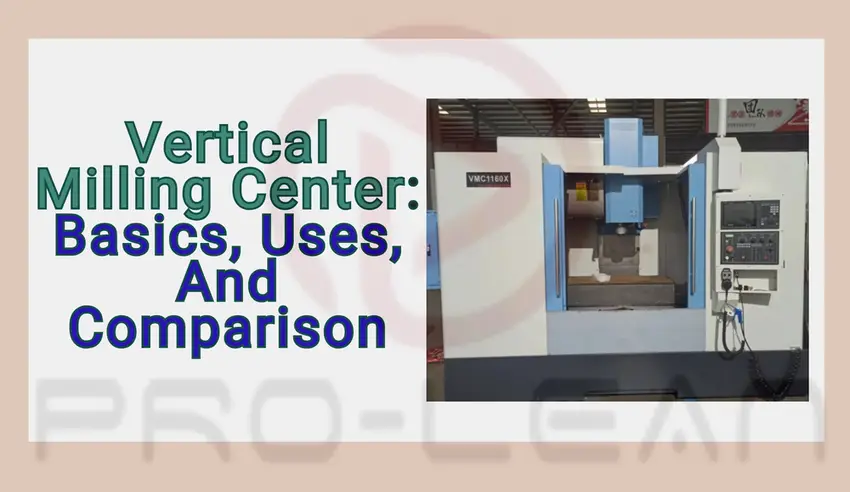
Vertical milling center
The vertical milling center is one of the most common types of machining centers, a class of efficient and versatile machines at the core of modern manufacturing. This machining center is recognizable for its vertical spindle orientation, equipped to cut and shape a wide range of material types and sizes.
Usually 3-axis or 5-axis in design, vertical milling centers are equipped with several handy features, including spindle speed rotation, integrated coolant system, automatic tool changer, and strong, dependable construction material. These and other features make the machine suitable for many manufacturing facilities where high-quality machined parts and short production times are necessary.
CNC machining centres from ProleanTech deliver accurate and precise parts for industries. Automotive, aerospace, electronics, and medical players heavily rely on this technology for parts and components.
Therefore, choosing vertical milling centers for your machined parts is an excellent idea considering the dynamism and proven dependability of these machines. In this article, we deep dive into the basics of these machines, highlighting applications, types, and capabilities.
Read on!
What Is A Vertical Milling Center?
A vertical milling center (VMC) is a CNC milling machine type with a vertical spindle orientation.
Various features make the VMC to perform many functions, the most notable ones being the rotary table, CNC technology, and automatic tool changers (ATC).
When integrated with a rotary table, the VMC is a beast. The efficiency, versatility, and accuracy of the machining process is high-level. This type of table enables the milling center to perform complex multi-sided milling in one setting.
The VMC is also characterized by CNC technology, which goes a long way in enhancing the manipulation of the cutting tools to multiple axes. With this, it is possible to produce holes, slots, shapes, and many other 3-D features.
Of course, the ATC is one of the mainstays of vertical milling centers f. The ATC enables the machine to quickly and efficiently change cutting tools, reducing cycle time and enhancing manufacturing efficiency.
What Is The Function Of Vertical Machining Center?
While milling is the primary function, this machine is engineered to perform several other functions including under CNC machining services;
- Drilling
- Tapping
- Boring
- Engraving
- Some turning
- Limited gear-cutting
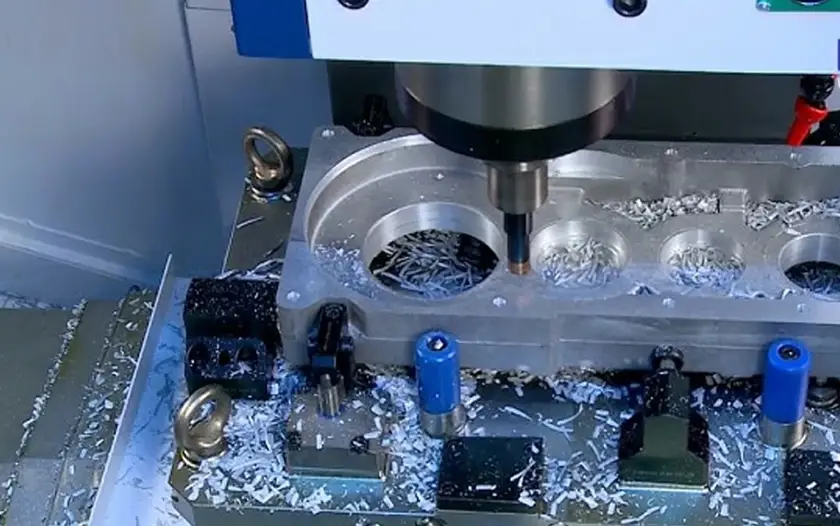
A machining process on a vertical milling center
The Working Principle Of A Vertical Milling Center
The vertical milling center has a straightforward working principle entailing the spindle-held cutting tool engaging the workpiece on the worktable. The main steps are as outlined below.
Step 1: Setting Up The Machine
Before starting the machining operation on the VMC, clean the table of any debris, coolant remnant, dirt, etc. Attach the workpiece on the worktable and make the necessary adjustments.
Step 2: CNC Programming
The vertical milling center operation, if CNC controlled, requires codes to be loaded via the control panel. So, this is the step where the G codes and M codes for the operation are added.
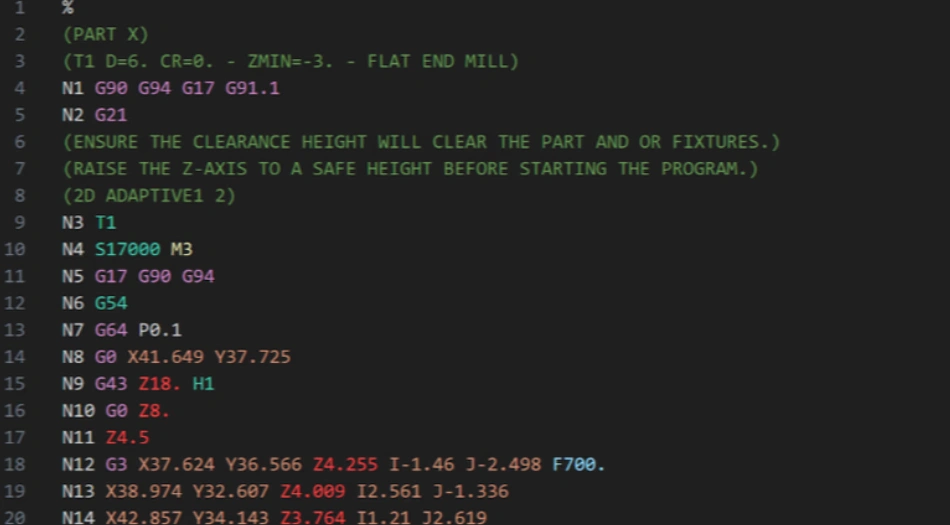
Machining codes
There are numerous codes for vertical milling including plane selection instructions, point positioning, and high-speed deep hole drilling. Don’t worry about this, seasoned machinists/programmers have no problem creating a program.
Furthermore, modern VMCs have conversational programming features so the machinist does not have to input code.
Step 3: Tool Selection
As many operations can be done on the vertical milling center, tool selection is a crucial part of the machining process. Generally, milling cutters include end mill, face mill, slab mill, and roughing end mill.
Consider these and other tool types available for your VMC and choose the most suitable one. Apart from the tool material, other guiding elements are tool diameter, tool coating, and angle of helix.
Step 4: Adjusting Cutting Parameters
To attain the desired cutting accuracy on the VMC, it is essential to adjust all the relevant cutting parameters – feed rate, cutting speed, angles, and so on.
Overall, these adjustments should be based on the type of cutting tool, surface finish requirements, workpiece material, and machine monitoring systems, among others.
Step 5: Milling Process
At this stage, the VMC executes the machining instructions, following the program to the last detail. The table holding the workpiece moves in the left-right direction along the X-axis as viewed from the machinist’s standing position. The forward-backward movement of the table is courtesy of the Y-axis.
The combination of these table movements, cutting parameters such as feed rate and depth of cut result in the envisaged final part – dimensions and shape.
Step 6: Quality Control
After vertical milling, the machined part is taken through quality checks to ensure it meets all the design and standard requirements. If the inspection process requires, the part can be adjusted or redone altogether.
Try Prolean Now!
Parts Of A Vertical Milling Center
The working principle of the vertical milling center described above has mentioned a few components, which together with others, combine to materialize the machining operations. Let’s dive into the specific parts of the VMC including the spindle, worktable, and automatic tool changer (ATC).
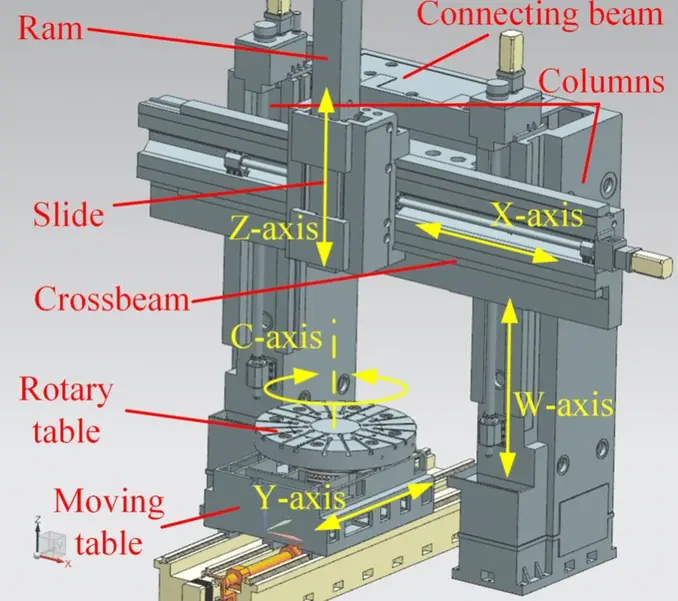
A vertical milling center
The Work Table
This is a stationary table that holds the workpiece as it is being machined. Work tables for modern VMCs have automation capability that allows for transverse and linear movement.
The Rotating Tables
To add to the standard work table, the vertical milling center can also be equipped with rotating tables. These are optional features, but they add a lot of capacity to the machine in terms of machining multiple sides of the workpiece and complex multi-axis machining.
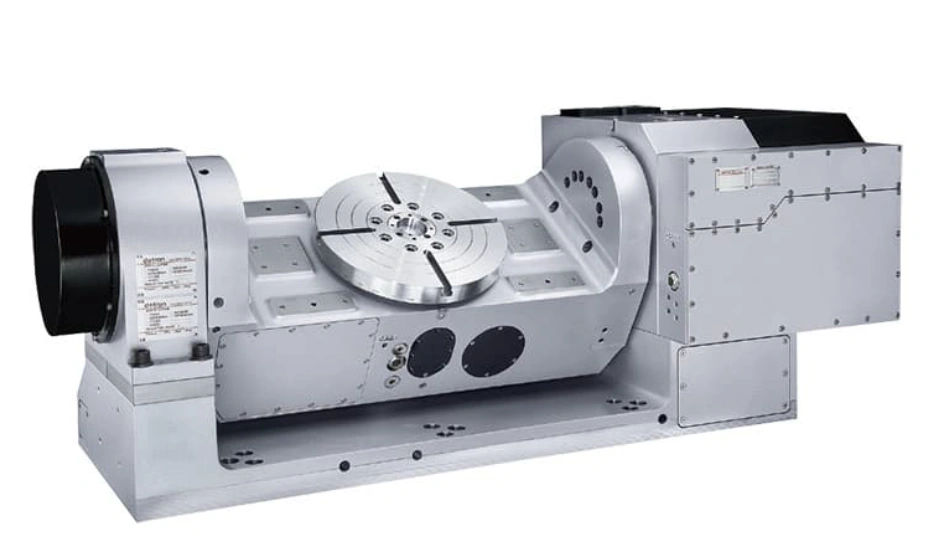
Rotating/tilting table
Coolant System
This system contains the machine’s cutting fluid supply system. It is important for not only cooling the workpiece and cutting tool but also enhancing chip evacuation.
Automatic Door Operation Mechanism
The automatic door operation mechanism is one of the safety mechanisms of the vertical milling center. It also promotes automation of the whole machine and improves manufacturing efficiency through faster automated cycles. It works through a combination of programmed commands and actuators.
Automatic Pallet Changer (APC) System
A pallet is an interchangeable and movable component of the vertical milling machine used to move finished or raw parts during loading and unloading. The best VMCs have automated pallet changer systems to enhance for the most reduced downtime.
The Spindle Section
The spindle area of the VMC comprises the spindle itself, power locks, and motors, among other components. Its fundamental function is to hold the cutting tools and rotate them at the requisite speed.
The motor system to the spindle can be directly or indirectly connected to the spindle, depending on the VMC’s design.
The Automatic Tool Changer (ATC)
The automatic tool changer is a system that removes the requirement for manual changeover of tools, thereby increasing the machining productivity. This mechanism is available as either chain or drum design.
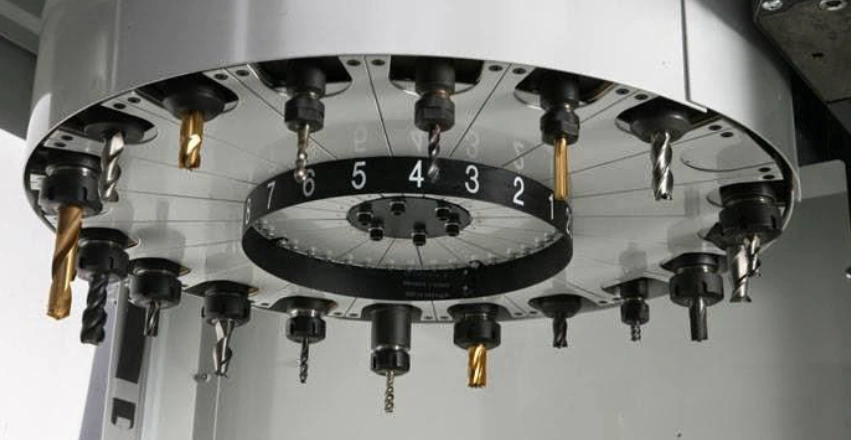
An automatic tool changer
The chain ATC design involves a chain and sprockets and a lock mechanism. The drum design is characterized by a drum-like tool magazine. The drum type holds fewer tools, but its change movement is relatively faster.
Applications And Uses Of Vertical Milling Centers
With the above coverage of the main components of the VMC, it is easy to understand the wide scale application of these machines. These incredible machining machines are present in precision tooling, automotive, aerospace and many other industries.
These applications reiterate the relevance of the VMC in the manufacture of critical components related to rapid prototyping, complex metal machining, and large-scale manufacturing. Many suppliers and end users explore CNC machining & its advantages in relation to VMC’s and choose to use them for the following applications”
-
Precision Tooling
Precision tooling is synonymous with the drilling of contours and cavities, as is the case in rapid tooling, mold-making, and die-making. These processes widely use VMCs for precision milling that helps make the required products.
-
Automotive Industry
Vertical milling machines are favored for curved parts with unusual shapes for the automotive industry. Whether it is steel, aluminum, or any other material, the technology can produce automotive parts such as intake manifolds, suspension parts, and engine brackets.
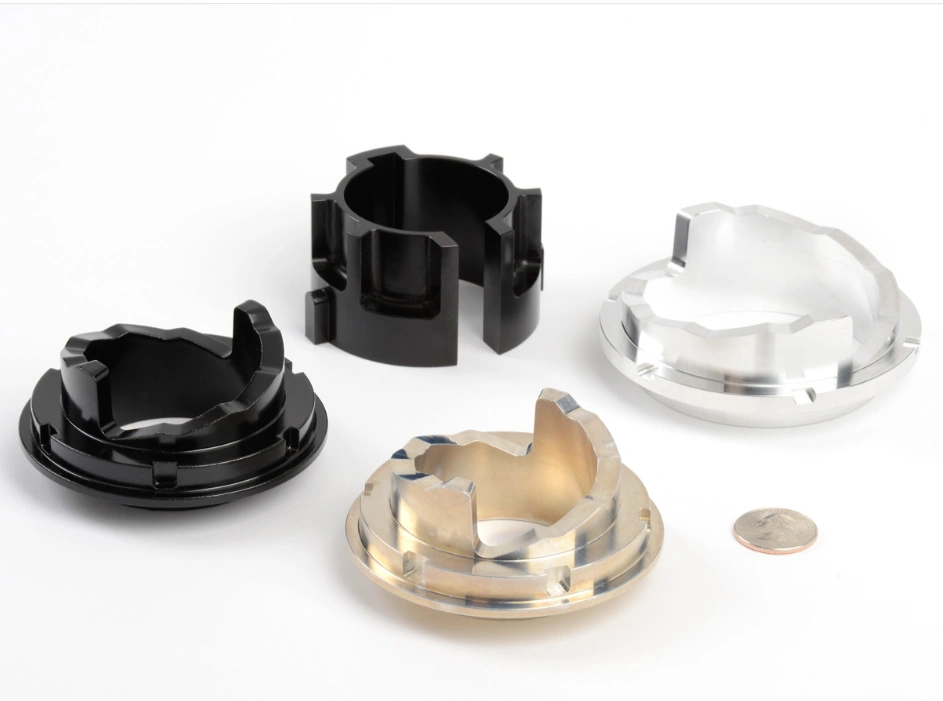
CNC milled automotive suspension parts
-
Aerospace Industry
The versatility, cost-efficiency, and precision of VMCs is critical for the aerospace industry, where complex parts are prominent. Different sizes and designs of aircraft frames and engine parts are some of the areas where manufacturers prefer this machining technology.
-
Medical Equipment
The modern medical equipment industry is a symbol of precision and quality. There is no better way to safeguard that requirement than to use a versatile, precise, and reliable technology – VMC.
This method is widely used to produce implants, surgical devices, prosthetics, and many other medical devices, using materials such as stainless steel and titanium.
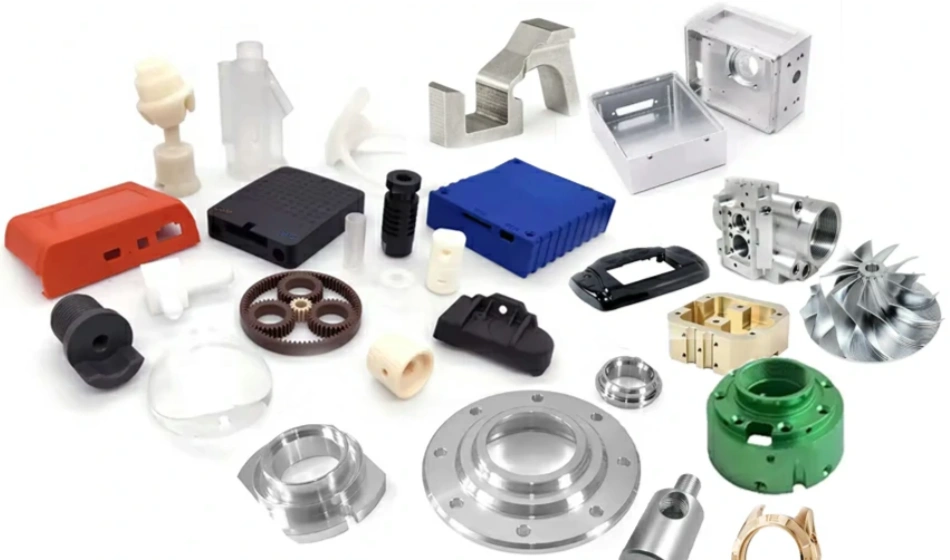
Medical parts
Try Prolean Now!
What’s The Difference Between CNC And VMC?
Some people, especially those searching for VMC services for the first time, can easily confuse the two terminologies. While CNC and VMC are common in machining circles, they refer to totally different things.
CNC refers to computer numerical control, which is a fundamental concept in machining for automating machines. Many types of machines fall under the CNC capability. That includes the VMC, which is the vertical machining center.
Which Is Better, VMC or HMC?
Having discussed a few aspects of the vertical milling center, and the difference between VMC and HMC, it is only worthwhile to check how the machine compares to the horizontal version. The differences arise from configurations, capabilities, machining efficiency, and a few other areas.
This comparison is important because the designs suit different manufacturing needs. The comparison table below gives a more vivid overview of each design:
| Property | Vertical Machining Center | Horizontal Machining Center |
| Spindle Design | Up-and-down | Side-to-side |
| Setup And Application | Easy to set for quick machining jobs | Relatively more demanding to set up; suitable for more complex jobs |
| CNC Machining Efficiency | Supports low-volume simpler machining jobs | Can comfortably handle high-volume complex jobs |
| Tool Access | Fundamentally built for 3 axes, but rotary attachment allows for expansion | 4 or more axes, thus more dynamic |
| Space Requirements | Compact design | Larger space requirement |
| Best Use Cases | Smaller production volumes, simpler geometries | Multi-face machining, larger production volumes |
As depicted from the table on vertical milling center vs horizontal milling center, the two machine designs differ on many elements including spindle orientation, space requirements, production volumes, and complexity of parts machined.
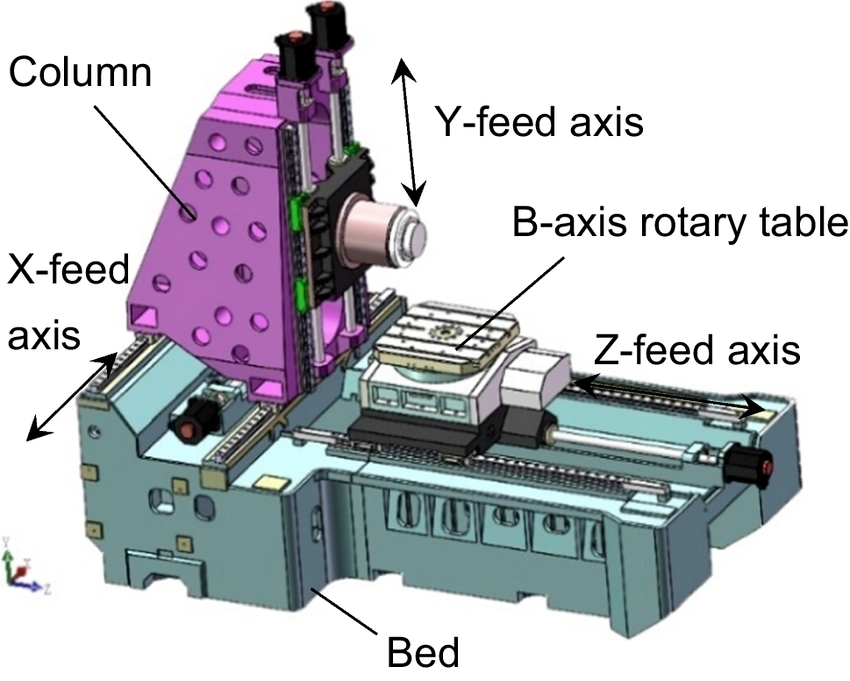
A horizontal milling center
Further reading: 3 axis vs 5 axis CNC
What Are The Advantages & Disadvantages Of A Vertical Machining center?
A vertical machining center is easy to set up and offers superior machining precision, reasons why small to medium manufacturing shops are fond of this technology. It tends to be more affordable than the horizontal machining center, although the HMC is better for heavier and larger workpieces.
Here are the advantages of the VMC in summary;
- Easier to access during setup and machining
- More compact design
- More affordable
- More precise on smaller workpieces
The disadvantages of the VMC are;
- Less suitable for larger parts
- Poor chip management
- Less spindle power
Selecting The Best Vertical Milling Center
After comparing vertical milling center vs horizontal milling center, you can now look at the factors China CNC machining services providers consider when choosing an ideal machine. The focus areas include raw material type, production volume, part complexity, and tolerance requirements.
Raw Material
CNC machining parameters are unique for different materials, so we must account for the differences in every setup. Consideration must be made on the capacity of a VMC based on the machinability of the material to be machined.
For instance, cutting forces and spindle speeds for aluminum are markedly different compared to those of hardened steel. Slower speeds are necessary for hardened steel, but aluminum workpieces can do with faster cutting speeds.
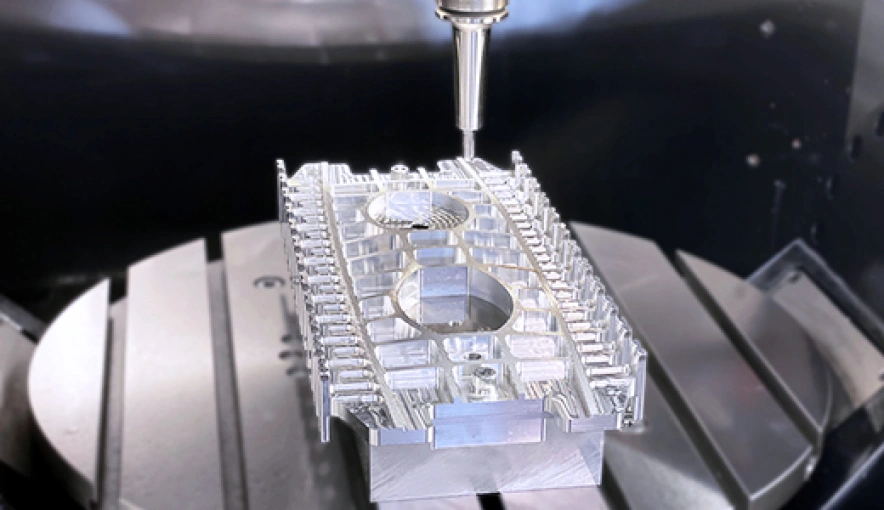
Milling an aluminum workpiece
Production Volume
The production volume for the VMC dictates the exact type or model of VMC to be used in any particular operation. If say hundreds of engine blocks are to be machined, the ideal setup is a specific VMC equipped with automated doors and tool changeover – this ensures little manual intervention and enhances efficiency.
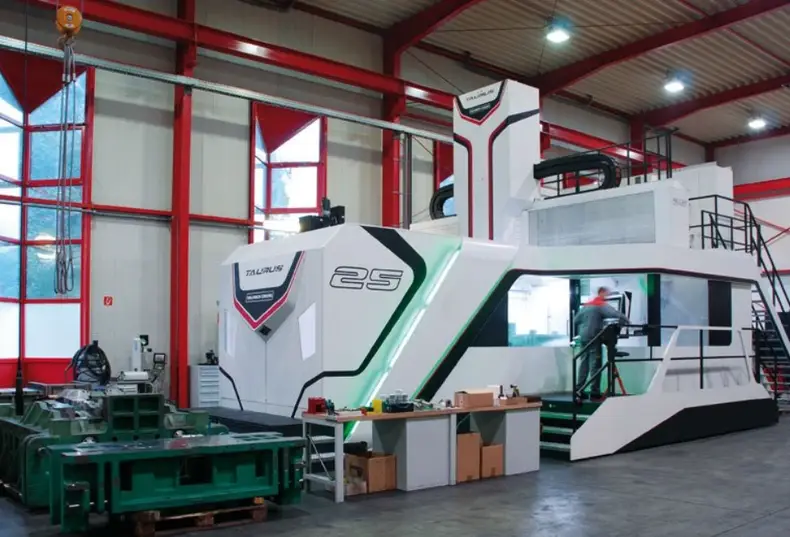
A large vertical milling center
For fewer parts, a more flexible equipment for small batch CNC machining can easily do the work, even if fixturing and tool changeover need a human touch.
Part Complexity
When machining highly complex parts, the choice of a VMC matters a lot. Instead of the common 3-axis machine, the more advanced 5-axis version is preferable because it can easily cut contours, undercuts, pockets, and so forth.
That would be the case when machining a motorcycle engine casing, which requires a lot of multi-sided machining.
Tolerance Requirements
The levels for tool calibration, sturdiness, and stability can differ from one vertical milling center to another. This means the tolerance performance is not the same for every machine you come across.
Where precise requirements are top priority, for instance, for aerospace brackets, the choice of VMC matters.
Read also: https://proleantech.com/cnc-machining-of-composites-everything-you-need-to-know/ and CNC Machining of Thermoplastics
What Are The Safety Rules For Vertical Milling Machines?
Vertical milling machines are reliable powerhouses, but working around them requires strict adherence to the following safety rules:
- Always wear personal protective equipment (PPE)
- Use quality and correct vises to secure tools and workpieces
- Countercheck setups and rotations
- Be conversant with the emergency procedures
- Performance maintenance according to the lockout/tagout procedures
- Always monitor the VMC during the machining process
Milling Center Operations At ProleanTech
At ProleanTech, CNC machining centres have the latest designs and superior machining capabilities. We have a variety of these machines so a broad range of precision parts for different industries can be CNC machined.
Running on the latest control systems and with unmatched rigidity, these machines provide reliable, accurate performance, which results in cost-effective parts.
Contact us today to learn more about the capabilities of our vertical milling centers and how they suit your business.

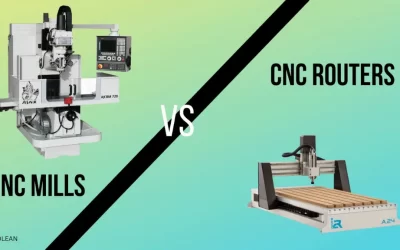
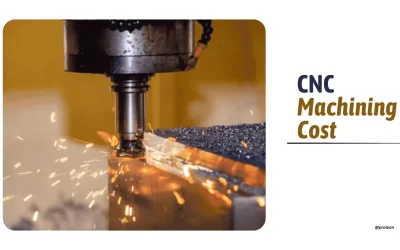
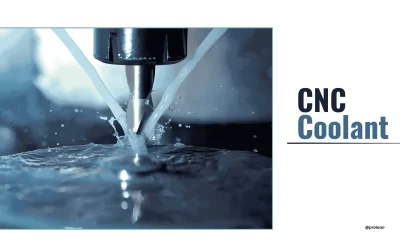
0 Comments